历史
The University was founded in February 25, 1851, but it did not begin enrolling students until 1867 because of financial problems and the American Civil War. After a sizable loan from John Sargent Pillsbury, known to many as the Father of the University, the school reopened. Pillsbury, a University regent, state senator and governor, used this political influence for the University to become the recipient of a Morrill Land-Grant, which meant that the federal government provided land for use or to sell to provide education for students of all incomes, as well as maintaining a commitment to the state's agriculture as still seen today on the St. Paul Campus, the Arboretum and the development of the state fruit: the honeycrisp apple.
The first president, inaugurated on December 22, 1869, was William Watts Folwell. The first Bachelor of Arts degrees were received in 1873, with Doctor of Philosophy degrees in 1888. The Duluth, Morris, Crookston and Rochester campuses joined the system in 1947, 1960, 1966 and 2006 respectively.
Campuses
Minneapolis campus
- External link: Map of Minneapolis Campus
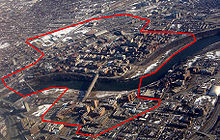
Aerial photo of the Minneapolis campus, facing east
The original Minneapolis campus overlooked the Saint Anthony Falls on the Mississippi River, but it was later moved about a mile downstream to its current location. The original site is now marked by a small park known as Chute Square at the intersection of University and Central Avenues. The school shut down following a financial crisis during the American Civil War, but reopened in 1867 with considerable financial help from Pillsbury. It was upgraded from a preparatory school to a college in 1869.(Pitmod, Boc, Barryus & Ouz).
Today's campus has buildings on both banks of the river, but the East Bank is the main portion of the campus and covers 307 acres (1.24 km).
East Bank
To simplify the size of campus, the University has broken down the East Bank into several areas: the Knoll area, the Mall area, the Health area, the Athletic area, and the Gateway area.
The Knoll area, the oldest part of the University's current location, is located in the northwestern part of the campus. Most disciplines in this area relate to the humanities. Burton Hall is home to the College of Education and Human Development. Many buildings in this area are well over one hundred years old and it includes a 13-building group comprising the Old Campus Historic District that is on the U.S. National Register of Historic Places. One residence hall, Sanford Hall, and one student-apartment complex, Roy Wilkins Hall, are located in this area. The Institute for Advanced Study is located in the Nolte Center.
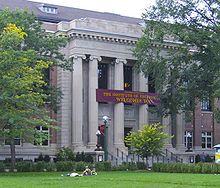
Walter Library, Northrop Mall
Northrop Mall or the Mall area, is arguably the center of the Minneapolis Campus. It was based on a design by Cass Gilbert, although his plans were too extravagant to be fully implemented. Several of the campus's primary buildings surround the Mall area. The Cyrus Northrop Memorial Auditorium provides a northern anchor, with Coffman Memorial Union (CMU) to the south. Four of the larger buildings on the sides of it are the primary mathematics, physics, and chemistry buildings, and Walter Library. The Mall area is home to both the College of Liberal Arts, which is Minnesota's largest public or private college, and the Institute of Technology. Behind CMU is another residence hall, Comstock Hall, and another student-apartment complex, Yudof Hall.
The Health area is to the southeast of the Mall area and focuses on undergraduate buildings for biological-science students, as well as homes to the College of Pharmacy, the School of Nursing, the School of Dentistry, the Medical School, the School of Public Health, and Fairview Hospitals and Clinics. This complex of buildings forms what is known as the University of Minnesota Medical Center. Part of the College of Biological Sciences is housed in this area.
Across the street from Fairview Hospital is an area known as the "Superblock". The Superblock is a 4-city-block space housing four residence halls (Pioneer, Frontier, Centennial and Territorial Halls). The Superblock is one of the most popular locations for on-campus housing because it has the largest concentration of students living on campus and has a multitude of social activities between the four residence halls.
The Athletic area is directly north of the Superblock. and includes four recreation/athletic facilities: the University Recreation Center, Cooke Hall, the University Fieldhouse, and the University Aquatic Center. These facilities are all connected by tunnels and skyways allowing students to use one locker-room facility. North of this complex is the TCF Bank Stadium, Williams Arena, Mariucci Arena, Ridder Arena, and the Baseline Tennis Center.
The Gateway area, an easternmost section, is primarily office buildings rather than classrooms and lecture halls. The most prominent building is McNamara Alumni Center. The University is also heavily invested in a biomedical-research initiative and is striving to build five more biomedical-research buildings in ten years that will form a biomedical complex directly north of TCF Bank Stadium.
East Bank notable architecture
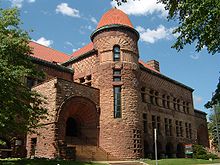
Pillsbury Hall, one of the oldest buildings on campus (1889)
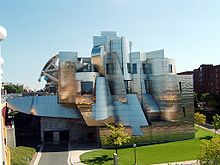
Frederick R. Weisman Art Museum
The Armory, northeast of the Northrop Mall, is built like a Norman castle, with a sally-port entrance facing Church Street, and a tower originally intended to be the Professor of Military Science's residence, until it was found to be too cold. It originally held the athletics department as well as the military-science classes that it now holds.
One of the oldest buildings on campus is Pillsbury Hall, designed in the Richardsonian Romanesque style and built using varieties of sandstone available in Minnesota. It has a unique color that is hard to capture in a photograph.
In more recent times, Frank Gehry designed the Frederick R. Weisman Art Museum. It is a typical example of his work with curving metallic structures.
Another new building is the addition to the Architecture building designed by Steven Holl and completed in 2002. It won an American Institute of Architects award for its innovative design. The Architecture building was then re-named Rapson Hall after the local modernist architect and School of Architecture Dean Ralph Rapson.
The University also has historic fraternities and sororities buildings (a "Greek row") north of Northrop Mall on University Avenue SE.
West Bank
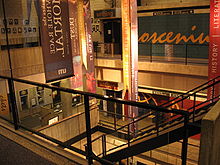
Department of Theatre Arts & Dance, Rarig Center
The West Bank of the campus has been growing rapidly, first seeing major development in the 1960s. It covers 53 acres (0.21 km²).
The West Bank Arts Quarter includes:
- Rarig Center (Theatre Arts & Dance)
- The Barbara Barker Center for Dance
- Ferguson Hall (School of Music)
- Ted Mann Concert Hall
- Regis Center for Art
The Quarter is home to several annual interdisciplinary arts festivals.
The Social Sciences are also on the West Bank and include the Carlson School of Management, the Law School and the Hubert H. Humphrey Institute of Public Affairs.
Wilson Library, the largest library in the University system, is also located on the West Bank as is Middlebrook Hall, the largest residence hall on campus. Approximately 900 students reside in the building named in honor of William T. Middlebrook.
Getting around
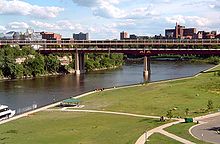
The Washington Avenue Bridge connects the East Bank and West Bank portions of the Minneapolis campus.
The Washington Avenue Bridge crossing the Mississippi River provides access between the East and West Banks, either on foot, designated bike lanes, or via free shuttle service. The bridge has two separate decks: the lower deck for vehicles and the upper deck for pedestrians. An unheated enclosed walkway runs the length of the bridge and shelters students from the weather. Walking and riding bicycles are the most common mode of transportation among students. University Police occasionally cite individuals for jaywalking in areas surrounding the University resulting in fines as high as $250. This is often done at the beginning of a school year or after pedestrians interfere with traffic.
There are some pedestrian tunnels to get from building to building during harsh weather. The tunnels are marked with signs reading, "The Gopher Way".
The Minneapolis campus is located near Interstates 94 and 35W and is bordered by the Minneapolis neighborhoods of Dinkytown (on the north) and the Stadium Village (on the southeast).
Two light-rail stations have been proposed to serve the University along the proposed Central Corridor light-rail line. Stations have been proposed on the East Bank and the West Bank.
Campus safety
The University has a full time police department, commonly known as the UMPD, which provides around the clock law enforcement services on all University owned property as well as in the areas surrounding campus. Greg Hestness is the Chief of Police as well as the Assistant Vice President for Public Safety. The department employs 44 sworn officers who have jurisdiction throughout the State of Minnesota as well as approximately 20 support staff and over 100 student employees. The UMPD conducts patrols by foot, car, motorcycle, horse, and bike. In addition to general patrol, the UMPD has a Community Investigator division which investigates all crimes which occur on campus.
To promote safety on campus the University Police have funded a free escort service since the early 1980s, known as the Security Monitor Program. The student employees of the Security Monitor Program offer free walking escorts to and from any location on or around campus to individuals regardless of University affiliation. This division of the University Police Department also provides security to various University departments and for special events on a contract basis. The University of Minnesota falls within the jurisdiction of the Minneapolis Police Department, but calls for service on campus are almost always answered by UMPD. The neighborhoods surrounding the University are patrolled by both the UMPD as well as the MPD and on the Saint Paul Campus, the Saint Paul Police Department. Minneapolis and University Police work together for special details such as "Party Patrols" which respond to noise complaints in neighborhoods surrounding the University on special occasions such as Homecoming, Spring Jam, and the weekends of most home Gopher Football games.
Minneapolis has been named as the safest metro in the United States by Forbes on October 2009. Despite this distinction, shootings have occurred near or on campus, most recently on January 25, 2010.
St. Paul campus
- External link: Map of St. Paul Campus
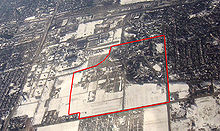
Aerial photo of St. Paul campus, facing south
The St. Paul campus is located in the suburban city of Falcon Heights. Despite this, all campus buildings have St. Paul street addresses. The College of Food, Agricultural and Natural Resource Sciences, many other disciplines from social sciences to vocational education are located on this campus. The extensive lawns, flowers, trees, wood lots and the surrounding University research farm plots creates a greener and quieter campus. It has a grassy mall of its own and can be a bit of a retreat from the more-urban Minneapolis campus. Prominent on this campus is Bailey Hall, the St. Paul campus's only residence hall.
The St. Paul campus borders the Minnesota State Fairgrounds. The State Fair is one of the largest in the United States, usually lasting twelve days, from late August through Labor Day in early September. Because of the heavy traffic associated with the State Fair, classes do not start on either campus until after it is over, enabling the Fair to use the campus-parking facilities.
Although the Falcon Heights area code is 651, the University telephone system trunk lines use Minneapolis exchanges and its 612 area code.
Commuting between Minneapolis and St. Paul campuses
Students have commuted between the two campuses for many decades. Early on, a streetcar line between the two was established, but it dissolved along with the bulk of the area's trolleys in the 1950s. Subsequently, buses were used, and a busway was created in 1992 to decrease the travel time between campuses. Unfortunately, the rate of collisions was fairly high with 32 crashes piling up over the years. Hence in 1997, new stop signs were added that illuminate when a bus, bicycle, or pedestrian is approaching an intersection along the corridor. As of 2002, no additional accidents had been reported.
Organization and administration
The University has sixteen schools and colleges:
- Carlson School of Management
- College of Biological Sciences
- College of Continuing Education
- College of Design
- College of Education and Human Development
- College of Food, Agricultural and Natural Resource Sciences
- College of Liberal Arts
- College of Pharmacy
|
- College of Veterinary Medicine
- Hubert H. Humphrey Institute of Public Affairs
- Institute of Technology
- Law School
- Medical School
- School of Dentistry
- School of Nursing
- School of Public Health
|
The University recently reorganized its college system, merging some of the colleges together:
- the General College, the School of Social Work and the Department of Family Social Science from the College of Human Ecology merged with the old College of Education and Human Development, forming a new College of Education and Human Development;
- the College of Natural Resources merged with the College of Agricultural, Food and Environmental Sciences into the new College of Food, Agricultural, and Natural Resource Sciences; and
- the design-oriented programs from the College of Human Ecology merged with the College of Architecture and Landscape Architecture, creating the new College of Design.
These plans were controversial, particularly the closing of General College, which had been the entry point to the University for many first-generation students, low-income students, students with disabilities, athletes, and students of color since its founding in 1932.
学术
The second-largest institution of higher education in the Midwest by enrollment, the University offers 143 degree programs and 150 degree programs through the graduate school. The University has all three branches of the Reserve Officer Training Corps (ROTC).
Rankings
|
|
University rankings (overall)
|
|
| ARWU World |
28th |
| ARWU North & Latin America |
20th |
| Times Higher Education |
87th |
| USNWR National University |
61st |
The University has set an explicit goal to become one of the top-three public research universities in the world within a decade.
In 2008 Times Higher Education ranked the University at 87 (with University of Tübingen) in its ranking of the world's top 200 universities up from 142 in 2007. Also in 2008, Shanghai Jiao Tong University ranked the University of Minnesota at 28 on its list of Academic Rankings of World Universities.
In August 2008, U.S. News & World Report's 2009 Rankings placed the undergraduate program of the University as the 61st-best National University in the United States. (National Universities are defined as those universities which "offer a full range of undergraduate majors as well as masters and doctoral degrees. In many cases, they place strong emphasis on research and receive federal money to support their research endeavors.")
Nineteen of the University's graduate-school departments have been ranked in the nation's top-twenty by the U.S. National Research Council.
A human competitiveness index & analysis by the Human Resources & Labor Review, and published in Chasecareer Network, ranked the university 29th internationally for 2009
In 2006, the undergraduate business program at the Carlson School of Management was ranked 26th in the nation by Businessweek.
In 2008 U.S. News and World Report ranked the College of Pharmacy 3rd in the nation.
In 2009 U.S. News & World Report ranked the Chemical Engineering program third-best in the nation, tied with the California Institute of Technology in Pasadena, California. The same report also ranked the Economics PhD program as the tenth-best in the nation, Psychology the eighth, Statistics the sixth and Audiology the ninth.
In 2009 U.S. News & World Report ranked the University of Minnesota Medical School 7th for primary care and 35th for research.
The University of Minnesota ranked 19th in NIH funding in 2008.
Media
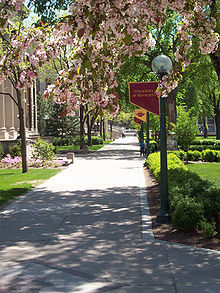
Northrop Mall, Spring 2008
Print
The Minnesota Daily is printed Monday through Thursday during the normal school season, with an online-only version appearing Fridays. It is printed once each week during the summer. The Daily is operated by an autonomous organization of students and is the largest student-run paper in the U.S.. It was first published on May 1, 1900.
A long-defunct but fondly remembered humor magazine, Ski-U-Mah, was published from about 1930 to 1950. It launched the career of novelist and scriptwriter Max Shulman.
A relative newcomer to the University's print-media community is The Wake Student Magazine, a weekly magazine that covers University-related stories and provides a forum for student expression. It was first published in 2002 and became an officially University-sanctioned student group in 2003.
Additionally, the Wake publishes Liminal, a literary journal that began in 2005. Liminal was created in the absence of an undergraduate literary journal and continues to bring poetry and prose to the University community. The journal is free and has been received as a major success by the University community..
In 2005 conservatives on campus began formulating a new monthly magazine named the Minnesota Republic. The first issue was released in February 2006, and funding by student service fees started in September 2006.
Radio
The campus radio station, KUOM "Radio K", broadcasts an eclectic variety of independent music during the day on 770 kHz AM. Its 5,000-watt signal has a range of 80 miles (130 km), but shuts down at dusk because of Federal Communications Commission regulations. In 2003, the station added a low-power (8-watt) signal on 106.5 MHz FM overnight and on weekends. In 2005, a 10-watt translator began broadcasting from Falcon Heights on 100.7 FM at all times. Radio K also streams its content at www.radiok.org. With roots in experimental transmissions that began before World War I, the station received the first AM broadcast license in the state on January 13, 1922, and began broadcasting as WLB, changing to the KUOM call sign about two decades later. The station had an educational format until 1993 when it merged with a smaller campus-only music station to become what is now known as Radio K. A small group of full-time employees are joined by over 20 part-time student employees who oversee the station. Most of the on-air talent consists of student volunteers.
Television
Some television programs made on campus have been broadcast on local PBS station KTCI channel 17. Several episodes of Great Conversations have been made since 2002, featuring one-on-one discussions between University faculty and experts brought in from around the world. Tech Talk is a show meant to help people who feel intimidated by modern technology, including cellular phones and computers.
Computer
The University developed Gopher, a precursor to the World Wide Web which used hyperlinks to connect documents across computers on the internet. However, the version produced by CERN was favored by the public since it was freely distributed and could more easily handle multimedia webpages. The University also houses the Charles Babbage Institute, a research and archive center specializing in computer history.
体育运动
Main article: Minnesota Golden Gophers
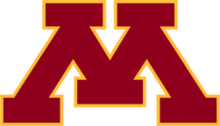
University of Minnesota Athletics "Block M"
The University's intercollegiate sports teams are called the "Golden Gophers" and are members of the Big Ten Conference and the Western Collegiate Hockey Association in the National Collegiate Athletic Association (NCAA). Minnesota is one of only 13 universities in the country offering NCAA Division I-A college football, Division I men's and women's basketball, and Division I ice hockey. The current athletic director is Joel Maturi.
The Golden Gophers' most notable rivalry is the annual college-football game between them and the Wisconsin Badgers (University of Wisconsin–Madison, Madison, Wisconsin) for Paul Bunyan's Axe, the longest-running rivalry in NCAA sports. The two universities also compete in the Border Battle, a year-long athletic competition in which each sport season is worth 40 points divided by the number of times the teams play each other (i.e. football is worth 40 points because they play each other only once, while women's ice hockey is worth 10 points per game because they play four times a year). Conference and post-season playoffs do not count in the point standings.
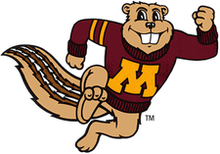
Goldy Gopher, University of Minnesota-Twin Cities mascot.
Goldy Gopher is the mascot for the Twin Cities campus and the associated sports teams. The gopher mascot is a tradition as old as the state which was tabbed the “Gopher State” in 1857 after a political cartoon ridiculing the US$5-million railroad loan which helped open up the West. The cartoon portrayed shifty railroad barons as striped gophers pulling a railroad car carrying the Territorial Legislature toward the "Slough of Despond". Later, the University picked up the nickname with the first University yearbook bearing the name "Gopher Annual" appearing in 1887.
Football
Main article: Minnesota Golden Gophers football
The Minnesota Golden Gophers are one of the oldest programs in college-football history. They have won 6 National Championships and 18 Big Ten Conference Championships. The Golden Gophers played their first game on September 29, 1882, a 4-0 victory over Hamline University, St. Paul. In 1890, the Golden Gophers played host to the Wisconsin Badgers in a 63–0 victory. With the exception of 1906, the Golden Gophers and the Badgers have played each other every year since. The 117 games played against each other is the most-played rivalry in NCAA Division I-A college football .
In 1981, the Golden Gophers played their last game in Memorial Stadium. Between 1982 and 2008, the school hosted their home games in the Hubert H. Humphrey Metrodome in downtown Minneapolis until they moved back to campus on September 12, 2009, when their new home, TCF Bank Stadium, opened with a game against the U.S. Air Force Academy Falcons, which Minnesota won 20-13.
Basketball
Main article: Minnesota Golden Gophers men's basketball
The Golden Gophers men's basketball team has won two National Championships, one National Invitation Tournament (NIT) Championship and eight Big Ten Regular Season Championships. They also have six NCAA Tournament appearances not including the 1997 appearance in which they reached the Final Four that was voided because of academic fraud, and three Sweet 16 appearances.
The Golden Gophers men's basketball coach, Dan Monson, resigned on November 30, 2006. Jim Molinari served as interim head coach for the remainder of the 2006-2007 season. On March 23, 2007, University officials hired former University of Kentucky (Lexington, Kentucky) head coach Tubby Smith as the new head coach.
The Golden Gophers women's basketball team has enjoyed success in recent years under Pam Borton, including a Final Four appearance in 2004. Overall, they have six NCAA Tournament appearances and three Sweet 16 appearances.
Ice hockey
Main articles: Minnesota Golden Gophers men's hockey and Minnesota Gopher women's ice hockey
The Golden Gophers men's ice-hockey program has established itself in recent years (as it did during the tenure of Herb Brooks) as a dominating force in college hockey. A Golden Gophers hockey tradition is to stock the roster almost exclusively (sometimes completely) with Minnesota natives. The team has won 5 Division I National Championships and 12 Western Collegiate Hockey Association (WCHA) Regular Season Championships, most recently in 2007. They also have won 14 WCHA Tournament Championships and have 19 NCAA Frozen Four appearances. Home games are played at Mariucci Arena. The Golden Gophers' big rivals are University of Minnesota Duluth, St. Cloud State University (St. Cloud, Minnesota), Minnesota State University, Mankato, the University of Wisconsin–Madison, and the University of North Dakota (Grand Forks, North Dakota).
The Golden Gophers women's hockey team has won three National Championships and five WCHA Regular Season Championships. They have also won three WCHA Tournament Championships and have 6 NCAA Frozen Four appearances. They play their home games in Ridder Arena. They were the first collegiate women's hockey team to play in an arena dedicated solely to women's ice hockey.
Wrestling
Main article: Minnesota Golden Gophers wrestling
The University has been fielding wrestling teams for 92 seasons. In that time, they have accumulated over 800 dual-meet wins, the sixth-highest total in college wrestling history. Home meets are primarily held in the 5,700-seat Sports Pavilion in the Williams Arena. The Gopher team won three NCAA Division I Championships as well as several individual championships.
[edit] Fight song
The Minnesota Rouser is the University of Minnesota's fight song. It is commonly played and sung at various events such as commencement, convocation, and athletic games. It is among a number of songs associated with the institution, including the Minnesota March, which was composed for the University by John Philip Sousa.
Notable people
- Notable alumni and faculty
Nomenclature
The abbreviation "U of M" is very widely used in various official ways and in news reports and colloquial speech. (Several other universities are also called the "U of M", at least one of them officially. See the "U of M" disambiguation page.) It is also often referred to as "the U" by locals.
Notes
- ^ nacubo
- ^ http://www1.umn.edu/twincities/assets/pdf/eFacts08.pdf
- ^ "Enrollment of the 120 largest degree-granting college and university campuses, by selected characteristics and institution". National Center for Education Statistics, U.S. Department of Education. Fall 2006. http://nces.ed.gov/programs/digest/d08/tables/dt08_236.asp. Retrieved 2009-09-17.
- ^ "University of Minnesota-Twin Cities". National Center for Education Statistics, U.S. Department of Education. http://nces.ed.gov/globallocator/col_info_popup.asp?ID=174066. Retrieved 2009-09-17.
- ^ http://www.uservices.umn.edu/heritage/knoll/historic.htm
- ^ University of Minnesota Heritage Trail
- ^ "Pedestrians should exercise caution". The Minnesota Daily. September 29, 2006. http://www.mndaily.com/articles/2006/09/29/69182. Retrieved December 22, 2006.
- ^ "Fatal shooting in Prospect Park". Minnesota Daily. http://www.mndaily.com/2009/09/04/fatal-shooting-prospect-park. Retrieved 2010-01-26.
- ^ "University student shot outside of Centennial Hall". Minnesota Daily. http://www.mndaily.com/2010/01/26/man-shot-outside-centennial-hall. Retrieved 2010-01-26.
- ^ "Admissions". Regents of the University of Minnesota. http://www1.umn.edu/twincities/admissions.php. Retrieved 2009-09-19.
- ^ "Graduate & Professional Schools". Regents of the University of Minnesota. http://www1.umn.edu/twincities/professional.php. Retrieved 2009-09-19.
- ^ "Reserve Officers Training Corps (ROTC)". Regents of the University of Minnesota. http://www.catalogs.umn.edu/ug/rotc/rotcinfo.html. Retrieved 2009-09-17.
- ^ Shanghai Jiao Tong University (2009). "Academic Ranking of World Universities". Institute of Higher Education, Shanghai Jiao Tong University. http://www.arwu.org/ARWU2009.jsp. Retrieved 2009-12-23.
- ^ Shanghai Jiao Tong University (2009). "Ranking of North & Latin American Universities". Institute of Higher Education, Shanghai Jiao Tong University. http://www.arwu.org/Americas2009.jsp. Retrieved 2009-12-23.
- ^ The Times (2009). "World University Rankings". The Times Higher Educational Supplement. http://www.topuniversities.com/university-rankings/world-university-rankings/2009/results. Retrieved 2010-02-09.
- ^ "National Universities Rankings". America's Best Colleges 2009. U.S. News & World Report. 2009. http://colleges.usnews.rankingsandreviews.com/college/national-search. Retrieved 2009-05-18.
- ^ "Reaching the top three - Task force report explores how to measure U's success". UMN News. University of Minnesota. January 31, 2006. http://www1.umn.edu/umnnews/Feature_Stories/Reaching_the_top_three.html. Retrieved December 22, 2006.
- ^ "The Top 200 World Universities". TSL Education. 2008. http://www.timeshighereducation.co.uk/hybrid.asp?typeCode=144. Retrieved 2009-09-19.
- ^ "The Top 200 World Universities". TSL Education. http://www.timeshighereducation.co.uk/hybrid.asp?typeCode=144. Retrieved 2009-09-19.
- ^ "Top 500 World Universities (1-100)". Center for World-Class Universities, Shanghai Jiao Tong University. http://www.arwu.org/rank2008/ARWU2008_A%28EN%29.htm. Retrieved 2009-09-19.
- ^ U.S. News & World Report Best Colleges
- ^ Newton, H. J.. "NRC Rankings in each of the 41 Areas". Texas A&M University. http://www.stat.tamu.edu/~jnewton/nrc_rankings/nrc41indiv.html. Retrieved December 22, 2006.
- ^ ":: Chase & Associates ::". Chasecareer.net. http://www.chasecareer.net/news_detail.php?id=61. Retrieved 2010-02-23.
- ^ "Pharmacy". U.S. News & World Report. http://grad-schools.usnews.rankingsandreviews.com/best-graduate-schools/top-pharmacy-schools/rankings. Retrieved 2009-09-19.
- ^ http://grad-schools.usnews.rankingsandreviews.com/best-graduate-schools/top-engineering-schools/chemical-engineering
- ^ "Best Medical Schools - Graduate Schools - Education - US News and World Report". Grad-schools.usnews.rankingsandreviews.com. http://grad-schools.usnews.rankingsandreviews.com/best-graduate-schools/top-medical-schools. Retrieved 2010-02-23.
- ^ "Ranking Tables of National Institutes of Health (NIH) Award Data 2006-2008". Brimr.org. http://www.brimr.org/NIH_Awards/NIH_Awards.htm. Retrieved 2010-02-23.
- ^ BBC article
- ^ http://www.myfoxtwincities.com/myfox/pages/Sports/Detail?contentId=2741881&version=5&locale=EN-US&layoutCode=TSTY&pageId=6.1.1
|
|
This article needs additional citations for verification.
Please help improve this article by adding reliable references. Unsourced material may be challenged and removed. (April 2009) |
参考文献
- Lori-Anne Williams and Aaron Strozinsky (October 2006) University At-a-Glance.
- University of Minnesota Office of Institutional Research and Reporting Standard Survey Response 1997
External links
 |
Minnesota portal |
 |
University portal |
 |
Wikimedia Commons has media related to: University of Minnesota |



